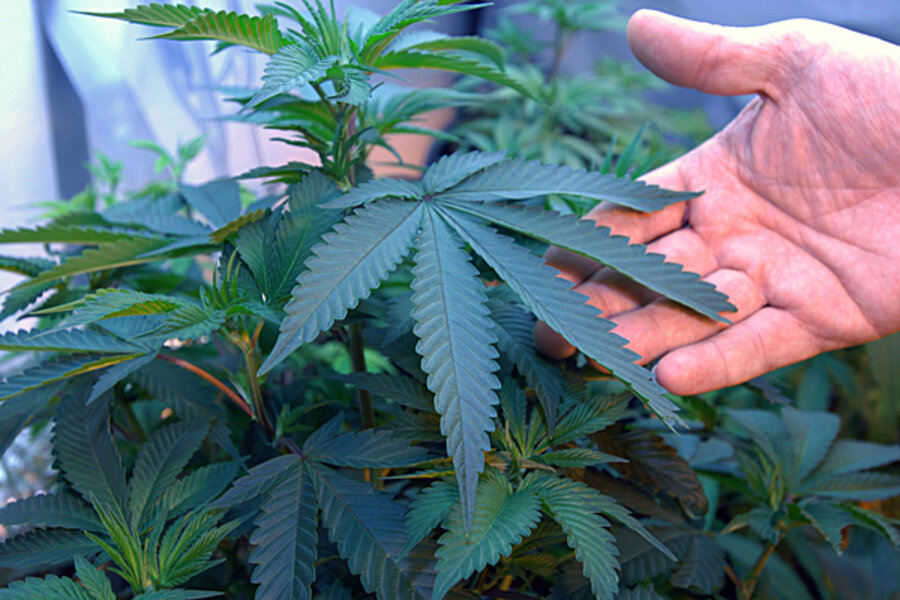Legal marijuana: Support soars to 58 percent, but local concerns remain
Loading...
The Gallup polling organization is reporting an eye-popping shift of 10 points in American attitudes toward marijuana legalization in the past year alone, with even older citizens warming up to the idea of replacing government pot bans with state regulation and taxation.
But what some marijuana advocates are calling a major tipping point in favor of pot legalization may not fully reflect how Americans feel about potentially having pot shops in their neighborhoods, or about marijuana smoke wafting over backyard fences.
After polling 1,028 US adults, Gallup reported Tuesday that 58 percent of Americans now support full marijuana legalization – a major shift from the 48 percent who supported it when Washington State and Colorado voters legalized pot last November. And while Americans who are 65 and older still on the whole oppose legalization, Gallup reports a 16-point swing toward lawful pot in that demographic in the past three years. Clear majorities of younger Americans support legalization, Gallup found.
The poll underscores a pivotal time for a movement whose goals not long ago seemed impossible, given America’s strong evangelical streak and traditional support for the so-called war on drugs. Yet even in liberal Denver, local politicians are pushing back against the open smoking of marijuana, and smaller towns are declaring they have no interest in seeing pot shops opening anywhere close to schools or quaint neighborhoods.
“There’s always a danger to assigning too much significance to a 10-point shift in public attitudes,” says Robert Mikos, a law professor and marijuana policy expert at Vanderbilt University in Nashville, Tenn. “If you read the wording of the [Gallup] question, it’s all about the use of marijuana, but what about distribution of marijuana? Should we legalize pot shops? At the local level, people are still leery of legalizing the trafficking side. There’s a lot less support for that stuff than simple possession.”
Nevertheless, the poll numbers are sure to further mobilize referendum activists across the United States, says Mason Tvert, communications director at the Marijuana Policy Project in Washington, D.C.
“The poll certainly bodes well for ongoing and upcoming efforts to change state laws,” Mr. Tvert says.
States including Oregon, California, Maine, Massachusetts, Nevada, Arizona, and Rhode Island are set to see major legalization efforts over the next two years. In California, Lt. Gov. Gavin Newsom said last week that marijuana should be legal in the Golden State.
The rapid shift in public opinion concerns antidrug advocates, who see the legalization movement pose dangers to American youths.
“We’re concerned about the impact that we’re going to see if we allow a big marijuana industry to rise up that will literally shadow the tobacco and alcohol industries,” Calvina Fay, executive director of the Drug Free American Foundation, told the Monitor this summer. “We already know the damage those industries have caused.”
Experience with the tobacco and alcohol industries, Ms. Fay notes, suggests they know that “if you want a faithful customer, you’ve got to hook them young” – which means that “we’re not just concerned about people smoking a joint in their living room, but about a huge industry that will proactively market to our children with horrible consequences.”
Oftentimes, major polling shifts precede changing laws, but part of the phenomenon of more-welcoming attitudes toward marijuana has to do with the medical marijuana movement, which began in 1996. Twenty states and the District of Columbia now allow medical marijuana dispensaries, according to the White House Office of National Drug Control Policy.
Moreover, the decision by the US Department of Justice earlier this year to allow states to create regulatory frameworks for marijuana as long as they don’t allow cross-border trafficking or use by children may also have played a role in softening the public’s attitudes, says Professor Mikos of Vanderbilt.
Cultural influences also have helped change opinions, or at least affirmed lingering beliefs, suggests Mr. Tvert of the Marijuana Policy Project. The decision by Dr. Sanjay Gupta, a well-known CNN personality, to apologize for his past opposition to medical marijuana may have moved the needle on the polling.
Also, according to Gallup, 38 percent of Americans acknowledge having tried the drug.






